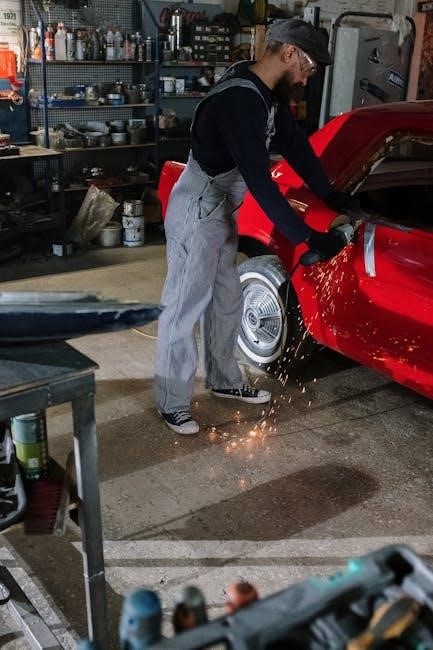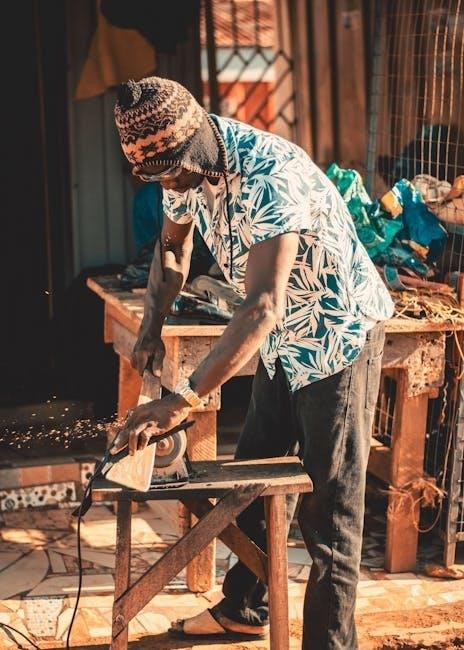Manual surface grinding machines are essential tools used to precisely grind and finish flat surfaces. They ensure accuracy and versatility in manufacturing processes, achieving high-quality finishes.
1.1 What is a Manual Surface Grinding Machine?
A manual surface grinding machine is a versatile tool used to grind, smooth, and finish flat surfaces of materials such as metals, plastics, and composites. It operates by using an abrasive grinding wheel that rotates at high speeds to remove material and achieve precise dimensions and surface finishes. Unlike automated CNC machines, manual grinders rely on operator input, making them ideal for small-scale production, repair work, and precision tasks. The machine typically consists of a sturdy base, a spindle assembly holding the grinding wheel, and a handwheel for manual control. By adjusting the wheel and workpiece alignment, users can accomplish intricate grinding operations with high accuracy. This equipment is widely used in workshops, machine shops, and manufacturing facilities for its adaptability and cost-effectiveness.
1.2 Importance of Manual Surface Grinding in Manufacturing
Manual surface grinding machines play a vital role in manufacturing by ensuring precise finishes on flat surfaces. They are cost-effective and offer control over grinding operations, making them ideal for small-scale production. These machines enable manufacturers to achieve high accuracy and surface quality, which are critical in industries like automotive and aerospace. Additionally, they provide flexibility for customizing grinding processes to meet specific requirements. Their reliability and ease of use make them indispensable in workshops and production lines, contributing to overall manufacturing efficiency and product quality. By enabling precise material removal, manual surface grinding machines help maintain consistency and excellence in finished products.

Key Components of a Manual Surface Grinding Machine
A manual surface grinder features a robust base, a precise spindle assembly, and a handwheel for controlled movement, ensuring stable and accurate grinding operations.
2.1 The Base and Its Role in Stability
The base of a manual surface grinding machine is its foundation, ensuring stability during operations. Typically made of cast iron, it provides rigidity and dampens vibrations, crucial for precise grinding. A stable base prevents machine wobble, maintaining accuracy and consistency in finished surfaces. Proper installation on a level floor is essential to maximize its stability. The base also houses key components like the spindle and motor, protecting them from external stresses. Regular maintenance, such as cleaning and checking for wear, ensures the base remains functional. A sturdy base is vital for the machine’s performance, directly impacting the quality of ground surfaces.
2.2 The Spindle and Grinding Wheel Assembly
The spindle and grinding wheel assembly are critical components of a manual surface grinding machine. The spindle, typically made of hardened steel, rotates the grinding wheel at high speeds, ensuring precise material removal. The grinding wheel, attached securely to the spindle, is designed for specific materials and surface finishes. Proper alignment and balancing of the wheel are essential for vibration-free operation and consistent results. The assembly’s durability and accuracy depend on regular maintenance, including cleaning and inspecting for wear. The spindle’s RPM range and wheel selection directly impact the machine’s performance, making this assembly central to achieving desired grinding outcomes.
2.3 The Handwheel and Its Function in Manual Operation
The handwheel is a critical component in manual surface grinding machines, enabling precise control over the movement of the grinding wheel or workpiece. It allows operators to adjust the position and alignment of the machine with ease, ensuring accurate grinding operations. The handwheel is typically connected to a screw or gearbox, translating manual effort into precise linear motion. This feature is essential for achieving the desired surface finish and dimensional accuracy. Operators can use the handwheel to feed the grinding wheel into the workpiece or move the table where the workpiece is mounted. Its ergonomic design ensures comfort during extended use, making it a vital tool for manual grinding tasks.

Types of Manual Surface Grinding Machines
Manual surface grinding machines come in two primary types: horizontal and vertical. Horizontal machines grind flat surfaces, while vertical machines are used for face grinding operations.
3.1 Horizontal Surface Grinding Machines
Horizontal surface grinding machines are designed with a horizontal spindle axis, allowing the grinding wheel to approach the workpiece from the side. These machines are ideal for grinding large, flat surfaces and are commonly used in workshops and manufacturing facilities. The horizontal orientation provides excellent stability and ease of operation, making them suitable for precision grinding of materials like metals, ceramics, and plastics. They often feature robust bases and advanced coolant systems to maintain thermal stability during prolonged operations. Widely used in automotive and aerospace industries, horizontal grinders are preferred for their versatility and ability to handle complex geometries with high accuracy.
3.2 Vertical Surface Grinding Machines
Vertical surface grinding machines are designed for grinding flat and rectangular surfaces. They feature a spindle that moves vertically, allowing for precise control over the grinding process. These machines are ideal for heavy-duty applications and are commonly used in industries where large or thick materials need to be ground. The vertical orientation enables efficient material handling and minimizes the risk of material warping. Operators can achieve high accuracy by adjusting the spindle’s movement and using appropriate grinding wheels. Vertical grinders are often preferred in foundries, shipbuilding, and heavy machinery manufacturing due to their robust construction and ability to handle demanding workloads.

Applications of Manual Surface Grinding Machines
Manual surface grinding machines are widely used in the automotive and aerospace industries for finishing metal parts, ensuring precise surface smoothness and dimensional accuracy.
4.1 Automotive Industry Applications
Manual surface grinding machines are widely used in the automotive industry for finishing engine components, cylinder heads, and other critical parts. Their precision ensures smooth surfaces, reducing friction and wear in engines, and improving overall vehicle performance. These machines are also employed for grinding brake rotors and flywheels, ensuring proper alignment and functionality. The ability to handle various materials, from steel to cast iron, makes them indispensable in automotive manufacturing. Additionally, they are used for reconditioning worn-out parts, extending component lifespan and reducing maintenance costs. Their versatility and accuracy make them a cornerstone in automotive production and repair workshops.
4.2 Aerospace and Precision Engineering
Manual surface grinding machines play a critical role in aerospace and precision engineering, where intricate components require flawless finishes. These machines are used to grind complex parts, such as turbine blades and gear components, ensuring dimensional accuracy. The aerospace industry demands high precision, and manual grinders are often preferred for their ability to handle delicate and high-value materials like titanium and advanced composites. Skilled operators utilize these machines to achieve tight tolerances and surface finishes, essential for the performance and safety of aircraft and spacecraft. Additionally, the ability to manually adjust grinding parameters allows for customization, making these machines indispensable in precision engineering applications where consistency and quality are paramount.

Advantages of Using Manual Surface Grinding Machines
Manual surface grinding machines offer cost-effectiveness and precision, providing better control for intricate tasks and ideal for small-scale production, ensuring high-quality finishes consistently.
5.1 Cost-Effectiveness Compared to CNC Machines
Manual surface grinding machines are a cost-effective alternative to CNC machines, offering significant savings in initial investment and operational costs. They require less complex setup and maintenance, making them ideal for small-scale production or specialized tasks. Unlike CNC machines, manual grinders do not demand extensive programming knowledge, reducing training expenses. Their simplicity ensures lower energy consumption and fewer overhead costs. Additionally, manual machines are more accessible for workshops with limited budgets, providing precision and versatility without the high costs associated with automated systems. This makes them a practical choice for manufacturers seeking efficient, economical solutions for surface grinding operations.
5.2 Precision and Control in Grinding Operations
Manual surface grinding machines offer unparalleled precision and control, enabling operators to achieve exacting tolerances. The hands-on nature of these machines allows for intricate adjustments, ensuring consistent results. By leveraging the operator’s skill, manual grinders can handle delicate materials and complex geometries with ease. This level of control is particularly valuable in producing high-quality finishes for critical components. However, achieving such precision demands a high degree of operator expertise, as even minor miscalibrations can affect outcomes. Despite this, the ability to manually fine-tune grinding parameters makes these machines indispensable in scenarios requiring utmost accuracy and flexibility.
Disadvantages of Manual Surface Grinding Machines
Manual surface grinding machines can be time-consuming for large-scale production and require highly skilled operators, potentially limiting efficiency and accessibility for smaller workshops or less experienced teams.
6.1 Time-Consuming Process for Large-Scale Production
Manual surface grinding machines can be a time-consuming option for large-scale production due to their reliance on operator input and the need for precise control. Each workpiece must be handled individually, which slows down the process compared to automated solutions. This method is less efficient for high-volume manufacturing, where speed and consistency are critical. Additionally, the requirement for skilled operators increases labor costs and production time. While manual grinding excels in precision and flexibility, it struggles to meet the demands of mass production, making it less suitable for industries requiring rapid output. This limitation highlights the trade-off between quality and efficiency in manufacturing workflows.
6.2 Requirement for Skilled Operators
Manual surface grinding machines require skilled operators to ensure precise and safe operation. Operators must understand the machine’s mechanics, grinding techniques, and material properties. Proper training is essential to avoid errors, achieve consistent results, and maintain workplace safety. Skilled operators can optimize grinding parameters, such as speed and feed rates, to prevent damage to both the machine and the workpiece. Additionally, they must be adept at inspecting and maintaining the equipment, including the grinding wheel’s condition and alignment. Inexperienced operators may lead to inaccurate finishes, reduced tool life, or even accidents. Therefore, investing in operator training and expertise is crucial for efficient and high-quality grinding operations.
Safety Precautions for Operating Manual Surface Grinding Machines
Always wear PPE, including safety glasses and gloves, to protect against flying debris. Ensure proper machine handling to prevent accidents and maintain a safe working environment.
7.1 Importance of Personal Protective Equipment (PPE)
Personal Protective Equipment (PPE) is crucial when operating manual surface grinding machines to ensure operator safety. Grinding processes generate sparks, flying debris, and dust, which can cause severe injuries. Safety glasses, goggles, or face shields protect eyes from harmful particles. Gloves prevent hand injuries and improve grip, while dust masks reduce inhalation of airborne particles. Proper attire, including closed-toe shoes and non-loose clothing, minimizes risks of entanglement or burns. Using PPE not only safeguards health but also ensures compliance with workplace safety regulations. Consistent use of PPE significantly reduces accidents and enhances overall operational safety in manufacturing environments.
7.2 Preventing Accidents with Proper Machine Handling
Proper machine handling is crucial to prevent accidents when using manual surface grinding machines. Operators should always ensure the machine is stable and level before use. Regular inspection of the grinding wheel for damage or imbalance is essential to avoid vibrations that could lead to loss of control. Additionally, workpieces must be securely clamped to prevent movement during grinding. Operators should keep loose clothing tied back and avoid jewelry that could get caught in moving parts. Maintaining a clean workspace reduces tripping hazards and ensures clear visibility. Finally, having emergency stop mechanisms easily accessible and knowing how to use them can prevent minor incidents from escalating into serious accidents.
Maintenance Tips for Manual Surface Grinding Machines
Regular cleaning and lubrication of moving parts ensure smooth operation. Always align and balance the grinding wheel to maintain precision and extend machine lifespan.
8.1 Regular Cleaning and Lubrication of Moving Parts
Regular cleaning and lubrication are crucial for maintaining the efficiency and longevity of manual surface grinding machines. Dust, metal shavings, and debris can accumulate and hinder smooth operation, so thorough cleaning of all moving parts is essential. Use compressed air or soft brushes to remove particles from crevices. Lubrication ensures friction reduction and prevents wear on components like bearings and spindles. Apply high-quality machine oil or grease as recommended by the manufacturer. Proper maintenance prevents overheating and extends the machine’s lifespan, ensuring optimal performance and precision in grinding tasks. Consistent upkeep also reduces the risk of unexpected breakdowns, keeping production processes uninterrupted. Regular servicing is vital for sustaining reliability and accuracy.
8.2 Aligning and Balancing the Grinding Wheel
Aligning and balancing the grinding wheel are critical for ensuring precise and efficient grinding operations. Proper alignment guarantees the wheel runs true, preventing uneven wear and surface defects. Balancing is equally important, as an unbalanced wheel can cause vibrations, leading to poor finish quality and potential damage to the machine. To align, use a diamond dresser to dress the wheel and adjust the spindle housing. For balancing, install the wheel on a balancing arbor and check for runout using a dial indicator. Correct any imbalance by adjusting weights or repositioning the wheel. Regular alignment and balancing maintain machine performance, reduce wear, and ensure consistent results.
Buying Guide for Manual Surface Grinding Machines
Assess specific needs, consider machine size, power, and precision. Evaluate brands, their reputation, and customer support. Ensure the machine meets safety and durability standards.
9.1 Factors to Consider When Choosing a Machine
When selecting a manual surface grinding machine, consider the machine’s build quality, brand reputation, and size. Ensure it aligns with workshop requirements and budget. Evaluate spindle power, table size, and travel range for specific tasks. Check the grinding wheel compatibility and ease of maintenance. Look for features like precise handwheel control and stable bases. Assess the manufacturer’s customer support and warranty offered. Compare models based on user reviews and industry recommendations to make an informed decision.
9.2 Evaluating Brands and Their Reputation
Evaluating brands and their reputation is crucial when selecting a manual surface grinding machine. A reputable brand ensures reliability, durability, and consistent performance. Research the manufacturer’s history, customer reviews, and industry ratings to gauge trustworthiness; Look for brands with a proven track record in producing high-quality grinding machines. Consider certifications and compliance with international standards, as these indicate adherence to quality and safety norms. Additionally, assess the brand’s after-sales support, such as warranty, service availability, and spare parts accessibility. A well-regarded brand often provides better technical assistance and troubleshooting, enhancing long-term satisfaction and machine longevity. Prioritizing reputation helps in making a wise investment for industrial or professional use.
Common Mistakes to Avoid When Using Manual Surface Grinding Machines
Incorrect grinding wheel selection and overlooking machine calibration are common errors that can lead to poor surface finishes and operational inefficiencies in grinding processes.
10.1 Incorrect Grinding Wheel Selection
Incorrect grinding wheel selection is a common mistake that can lead to poor surface finishes, reduced tool life, and even machine damage. Choosing the wrong abrasive type or grit size for the material being ground can result in inefficiency and costly rework. For instance, a wheel designed for steel may not perform well on aluminum, causing excessive heat buildup or uneven grinding. Operators must consider the material properties, desired finish, and grinding operation when selecting a wheel. Referencing manufacturer guidelines and material specifications helps ensure the correct choice. Proper training and experience are essential to avoid this error, as it directly impacts productivity and product quality. Always match the grinding wheel to the specific application to achieve optimal results and maintain machine performance. Regularly updating knowledge on new abrasive technologies also minimizes such mistakes.
10.2 Overlooking Machine Calibration
Overlooking machine calibration is a common mistake that can lead to inaccurate grinding results. Proper calibration ensures the machine operates within precise parameters, maintaining consistency and quality. Neglecting this step can result in uneven surfaces, misalignment, or even damage to the workpiece or grinding wheel. Operators must regularly check and adjust the machine’s alignment, spindle, and table to ensure optimal performance. Failure to calibrate can also lead to increased vibration, reduced tool life, and higher production errors. Always refer to the manufacturer’s guidelines for calibration procedures to avoid such issues and maintain the machine’s efficiency and accuracy in grinding operations.
